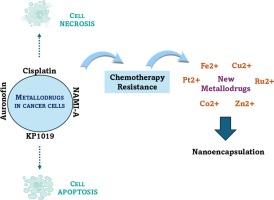Metallodrugs: Synthesis, mechanism of action and nanoencapsulation for targeted chemotherapy
IF 5.3
2区 医学
Q1 PHARMACOLOGY & PHARMACY
引用次数: 0
Abstract
As a multifactorial and heterogeneous disease, cancer has a high mortality rate, and the search for more effective treatments is an enormous challenge. Metal coordination compounds open a range of possibilities that conventional organic and biological molecules can no longer fulfil due to increasing drug resistance. Metallodrugs still have tremendous potential to help overcome drug resistance and find new cures in medicine, considering that at least 25 metallic elements participate in healthy functioning of the human body. Transition metal ions, such as copper, zinc and iron, are incorporated into catalytic proteins, the so-called metalloenzymes, which participate in various chemical reactions necessary for life. The interaction of metal complexes in different pathways with the structural richness of deoxyribonucleic acid encouraged to seek to understand the mechanisms of action and overcome the obstacles encountered for a promising future of these drugs. The success of platinum-based metallodrugs is one of the great inspirations for the search of new metallodrugs, although the approval of these molecules has been slow in recent years due to the risk of systemic toxicity and insufficient understanding of their mechanisms. To overcome the clinical limitations encountered in some metallodrugs, nanoencapsulation has been proposed as a new approach to improve therapeutic index in chemotherapy. The remarkable selectivity of nanoencapsulated metallodrugs and their enhanced capacity to bypass various biological barriers allow site-specific targeting. In this review, we present the advances in the development and use of the most relevant metallodrugs, and new delivery approaches, in the fight against cancer.

金属药物:用于靶向化疗的合成、作用机制和纳米封装。
癌症是一种多因素和异质性疾病,死亡率很高,寻找更有效的治疗方法是一项巨大的挑战。金属配位化合物开辟了一系列可能性,而由于抗药性的不断增加,传统的有机分子和生物分子已无法满足这些可能性。考虑到至少有 25 种金属元素参与人体的健康运作,金属药物在帮助克服耐药性和寻找新的治疗方法方面仍具有巨大的潜力。铜、锌和铁等过渡金属离子被纳入催化蛋白质,即所谓的金属酶,参与生命所需的各种化学反应。金属复合物在不同途径中与结构丰富的脱氧核糖核酸的相互作用,促使人们寻求了解其作用机制,并克服所遇到的障碍,使这些药物的未来充满希望。铂类金属药物的成功是寻找新金属药物的重要启迪之一,尽管由于存在全身毒性风险以及对其作用机制的认识不足,近年来这些分子药物的审批进展缓慢。为了克服某些金属药物在临床上遇到的局限性,人们提出了纳米包囊作为提高化疗治疗指数的一种新方法。纳米包囊金属药物具有显著的选择性,并能增强绕过各种生物屏障的能力,从而实现特定位点靶向。在这篇综述中,我们将介绍在开发和使用最相关的金属药物方面取得的进展,以及抗击癌症的新给药方法。
本文章由计算机程序翻译,如有差异,请以英文原文为准。
求助全文
约1分钟内获得全文
求助全文
来源期刊

Biochemical pharmacology
医学-药学
CiteScore
10.30
自引率
1.70%
发文量
420
审稿时长
17 days
期刊介绍:
Biochemical Pharmacology publishes original research findings, Commentaries and review articles related to the elucidation of cellular and tissue function(s) at the biochemical and molecular levels, the modification of cellular phenotype(s) by genetic, transcriptional/translational or drug/compound-induced modifications, as well as the pharmacodynamics and pharmacokinetics of xenobiotics and drugs, the latter including both small molecules and biologics.
The journal''s target audience includes scientists engaged in the identification and study of the mechanisms of action of xenobiotics, biologics and drugs and in the drug discovery and development process.
All areas of cellular biology and cellular, tissue/organ and whole animal pharmacology fall within the scope of the journal. Drug classes covered include anti-infectives, anti-inflammatory agents, chemotherapeutics, cardiovascular, endocrinological, immunological, metabolic, neurological and psychiatric drugs, as well as research on drug metabolism and kinetics. While medicinal chemistry is a topic of complimentary interest, manuscripts in this area must contain sufficient biological data to characterize pharmacologically the compounds reported. Submissions describing work focused predominately on chemical synthesis and molecular modeling will not be considered for review.
While particular emphasis is placed on reporting the results of molecular and biochemical studies, research involving the use of tissue and animal models of human pathophysiology and toxicology is of interest to the extent that it helps define drug mechanisms of action, safety and efficacy.
 求助内容:
求助内容: 应助结果提醒方式:
应助结果提醒方式:


